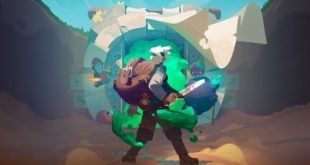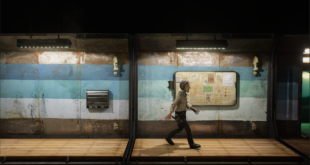With the barrier to entry lower than ever, more people are exploring the possibilities of games development. One of the latest to take the plunge is Clint Siu (pictured), a visual effect artist with more than ten years of experience working on film, TV and music videos.
Siu had been keen to try something new for a while when he heard about Stugan, the Swedish games accelerator founded by veteran developers from Rovio, Mojang, EA, King and more. The key selling point for Stugan is that applicants spend two months making games in a cabin in the woods.
“It sounded amazing,” Siu tells Develop. “I really wanted to apply but wasn’t developing anything at that time, so I took a couple weeks to prototype lots of different things.
“Almost everything I threw out, except an idea of dragging a UI box and twisting it with my fingers. It felt like Minority Report when Tom Cruise is moving around little windows on that giant transparent screen. That was fun to me.
“I expanded on that initial concept by having geometry act as a base holding the UI elements and having a camera that can move freely around the 3D scene. I sent that as my application video to Stugan, and I guess they liked it enough to accept me in.”
The idea would eventually evolve into Prism, a surreal puzzle game about “exploring a microcosmic galaxy and unfolding sacred geometry”, according to Siu. Put simply, players drag and rotate coloured dots and lines to match the symbols on geometric shapes, thus solving each puzzle.
And Siu’s inspiration is far more classical than you might think: “It came from Plato’s classical elements in Timaeus. He associated each of the five elements – fire, earth, air, water, ether – with a Platonic solid: geometry that has the same polygon on all sides. I thought about how geometry is what we use to measure the world, but what do we use to measure the soul? That question led to the essence of what’s inside Prism.”
LOOKING FOR UNITY
The title is built using Unity, a game engine for which Siu has since become a big fan. The transition from his usual toolset of digital content creation software such as Autodesk’s Maya was relatively easy, with a lot of the hotkeys and navigation tricks the same across both Maya and Unity.
The biggest obstacle was programming and Siu’s limited knowledge of C#.
“I had taken a 10-week class on scripting for [Maya scripting language] MEL a few years back that taught me the basics of programming,” he explains. “It was enough to actually start coding my own games. But the syntax is quite different than C#, so it became a lot of going back and forth from the Unity docs and Googling for code examples.
“Of course, Unity also has an asset store that I’m grateful for. Nine times out of ten, there’d be something really difficult for me to program that already had a package available on the store.”
Siu’s background as a visual effects artist for Hollywood also helped inspire the game’s visual style, with the developer naming J.J. Abrams movies such as Super 8 and Star Trek as references. He also looked closely at the work of artists like GMunk.
“I really wanted a game that felt cinematic, but it also had to be something that I could finish as a one person team,” he says. “I gave myself the constraint of only using a few pieces of simple geometry as the main focal point. Secret Exit did that with Zen Bound and Zen Bound 2 with incredible results, so I knew it was possible. The thing that makes it visually interesting is the way light reacts to the object.”
A RELAXED SOUNDSCAPE
Lighting played a major role in giving Prism the cinematic sheen Siu was hoping for. While many mobile games are devoid of dynamic lighting, he required at least one such light to create glistening highlights on the faces of his various geometric shapes.
“The way light starts on one edge, rolls and flicks along the surface, and gets cut off at another edge has a magical quality that I wanted to capture,” he explains. “The way specularity varies on a surface is something that isn’t used as often in mobile games as it is in film.
“In the real world, surfaces have imperfections, grooves, smudges or fingerprints that break up the light. If something is smooth and shiny, it creates a brighter highlight. If something is rough and dull, it creates little to no highlight. With Unity’s standard shader, I used a gloss map to define a surface’s glossiness to achieve a similar effect.
“Lens flares, chromatic aberration and depth of field are effects used a lot in CG and motion graphics, and they are a big part of Prism’s visual style as well. These are all optical effects that suggest the image is produced from a camera with a lens. They help film CG renders to composite and integrate better with footage.
“The same thing can apply to games, helping it feel more photographic. To achieve this, I used Unity’s Vignetting and Chromatic Aberration image effect from their standard assets. For the lens flares, I used Proflares from the asset store.”
The music and audio was also important, with Siu aiming for a “relaxed, meditative” soundscape that would put players at ease. Given Prism’s futuristic look, he chose to experiment with synthesizers as the most appropriate instrument. Using the copy of Garageband already installed on his Macbook, Siu chose some of the synth presets and began tweaking parameter knobs until he found a sound he liked. To add to
the ‘spacey’ feeling, he used a lot of reverb.
“Garageband has a neat remote app that lets you use an iPad as a virtual keyboard/midi controller,” Siu says. “Which is great because I could visualize keys and actually play chords instead of having to pencil in all the midi notes by hand.”
VOODOO MAGIC
Last, but by no means least, there is the control scheme. Touchscreen controls are one of the biggest factors that attracted Siu to games development in the first place, and with Prism he was finally able to explore this.
“It’s so incredible that I could touch an object on a screen and make it move simply by moving my finger – that’s voodoo magic to me,” he says. “I wanted it to be like that in Prism as well. I wanted the controls to feel very natural and intuitive, so intuitive that small children could just figure out what to do without instruction.
“This was also the biggest challenge. I didn’t want to put an explicit tutorial or words in the game because that would break some of the zen, meditative feeling. So how do you tell a child what to do without telling them what to do?”
In the end, he spent a lot of time going back and forth between user testing and redesigning the first handful of levels. Over time, these stages essentially became an unofficial tutorial, gradually easing players into understanding what can be interacted with and in what ways.
“The biggest lesson I learned was to build a system or framework that can be easily changed,” Siu says, looking back on his first games development experience. “Because things will definitely change. Next time, I’ll figure out better ways to put repetitive or error prone things into code. It’s really tedious having to drag and drop things by hand. Time for me to learn more programming skills.”

 MCV/DEVELOP News, events, research and jobs from the games industry
MCV/DEVELOP News, events, research and jobs from the games industry



